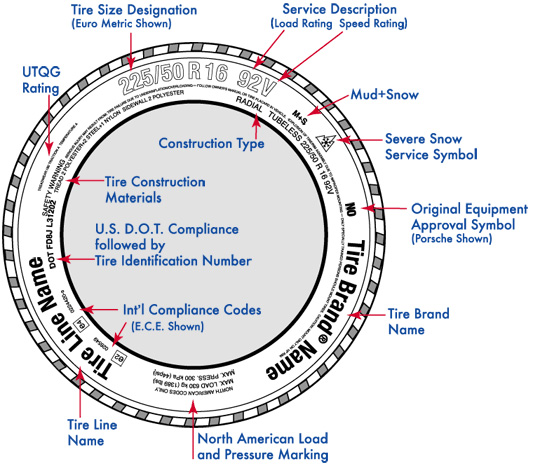ABC News and other have gone undercover and found retailers selling aged tires as brand new.
What your sidewall says to you. . . .

Automobile Tire Sidewall Markings:
You will find plenty of information about the tires installed on your car by looking at the sidewall markings that are put there by the manufacturer. In addition to the tire's brand and model names you will find information showing the tire's overall dimensions and the date code (when the tire was made).
Also listed are the materials used to internally reinforce the rubber, the load range and maximum inflation pressure. There will also be a manufacturer's certification that their tire meets the industry standard and government regulations from the country it was produced in.
Determining the Age of a Tire:
It is a fairly straight forward task to determine the age of a tire by looking at the sidewall and finding the Tire Identification Code (TIC), or serial number. Unlike other serial numbers on a car, the T.I.C. is more of a batch code that identifies the week and year the tire was produced, likening it to the code you would find on an engine block, cylinder head, and other replaceable parts on a car.
As required by the U.S. Department of Transportation National Highway Safety Administration (DOT NHTSA), the T.I.C. must be a combination of eleven or twelve lettters and numbers that identify the manufacturing location, tire size, manufacturer code, and the week and year the tire was manufactured.
The last four digits of the serial number represent the week and year of production on tires maunfactured in the year 2000 and later, with the first two of the four digits representing the week, and the last two representing the year. On tires manufactured in 1999 and earlier, there is a three digit code used with the first two digits representing the week and the last digit representing the year. This system was used because the DOT didn't think there would conceivably be tires still in use after ten years, eliminating the need for a millenium code change.
Some examples of tire date coding since 2000 follow:
XXXXXXXX 0600 06 = the 6th week of the year, or the second week of February 00=the year 2000
XXXXXXXX 0604 06 = the 6th week of the year 04=the year 2004
Some examples of tire date coding prior to 2000 follow:
XXXXXXXX 068 06 = the 6th week of the year 8=the 8th year of the decade, this could be 1998, 1988 etc.
In the last example the tire was shown to be made in the 8th year of the decade, but there was no universal identifier in place at the time to confirme which decade was represented (tires made in the 1980's may have a small triangle following the Tire Identification Code to signify that decade). The T.I.C. used since the year 2000 accurately confirms the production year.
And finally, hold on to your sales receipts. Most tire manufacturer's warranties cover their tires for four years from the date of purchase, or five years from the week the tires were manufactured. So if you purchase new tires that were manufactured exactly two years ago they will be covered for a total of six years (four years from the date of purchase) as long as you have your receipt. If you lose your receipt, your tires' warranty coverage will end five years from week the tire was produced (resulting in the tire manufacturer's warranty coverage ending only three years from the date of purchase in the example above).






